|
Some
paragraphs extracted from
the Traveler's Ecuador Companion © The
Globe Pequot Press. Reproduced with permission.
Photos
by Dominic Hamilton.
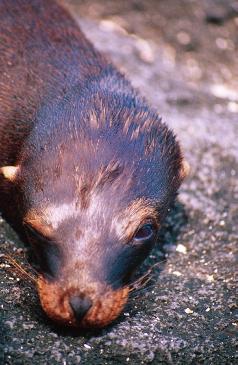 Stepping
onto the beach on one of the Galápagos Islands you could well
find yourself surrounded by dozens of sunbathing sea lions
lying about on the sand like so many sacks of potatoes. Stepping
onto the beach on one of the Galápagos Islands you could well
find yourself surrounded by dozens of sunbathing sea lions
lying about on the sand like so many sacks of potatoes.
As you approach, they don't blunder off into
the sea or shuffle behind a rock, as you might expect; they
keep on sleeping in the sun or stare at you with studied indifference.
If you stand within a meter or two they might snarl or bark
with a sound that's a cross between a pig's oink and the klaxon
of antique car, as if to say, "This is my space." But they
are unlikely to be aggressive towards you, nor frightened.
Walking along rocky shorelines, you encounter blue-footed
boobies laying eggs on the pathways who show not the slightest
concern at your presence. They don't bat an eye if you approache
within a meter. Prehistoric marine iguanas, which look like
miniature dragons or extras from a science fiction movie,
eye you languorously from jagged lava rocks and hardly deign
to move if you poke a camera lens within a few inches of their
glistening heads.
For hundreds of years human visitors have commented
on the abundance and tameness of the wildlife in these remote
and isolated islands that straddle the equator in the Pacific
Ocean, about 1,000 km (625 miles) off the coast of Ecuador.
In fact, the word tame isn't quite accurate since it implies
domesticated wildlife. For the most part animals of the Galápagos
have evolved and lived without fear of predators common in
other parts of the world, neither human nor four-legged.
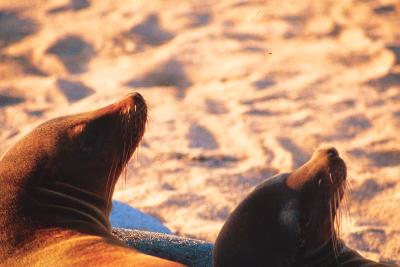 This
absence of fear on the part of the birds and animals, make
human visitors feel an extraordinary, uplifting harmony with
nature that cannot be experienced anywhere else on earth.
It's for good reasons the Galápagos Islands have often been
called the Garden of Eden. This
absence of fear on the part of the birds and animals, make
human visitors feel an extraordinary, uplifting harmony with
nature that cannot be experienced anywhere else on earth.
It's for good reasons the Galápagos Islands have often been
called the Garden of Eden.
For equally good reasons, the archipelago is
also known as the world's greatest natural laboratory of evolution.
Ever since Charles Darwin's visit in 1835, scientists have
been drawn to the islands to study creatures that evolved
in isolation from their cousins on the mainland. Darwin was
interested in the various species of finches, all of which
had adapted to local conditions and evolved in different ways.
The islands continue to attract scientists from all over the
world, and the Charles Darwin Research Station on Santa Cruz
is an important center for their activities.
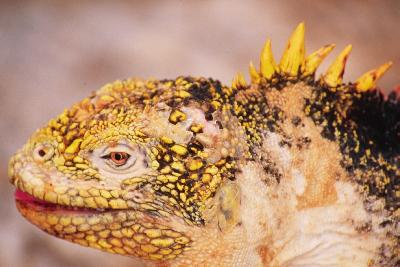 In
1959, responding to a growing awareness of the environmental
and scientific importance of the archipelago, Ecuador designated
97% of the 8,000 sq km (3,088 square miles) land area of Galápagos
as a national park. In
1959, responding to a growing awareness of the environmental
and scientific importance of the archipelago, Ecuador designated
97% of the 8,000 sq km (3,088 square miles) land area of Galápagos
as a national park.
In 1986, the Galápagos Marine Resources Reserve
was established, protecting the water around the archipelago.
UNESCO has also recognized the islands as a Man and Biosphere
Reserve, and as a World Heritage Site.
Ecuador manages the islands through the Galápagos
National Park Service, which has offices in Puerto Ayora on
Santa Cruz. Nearby is the Charles Darwin Research Station,
run by the Charles Darwin Foundation. The Research Station
carries out scientific research and assists the Park Service.
The Galápagos National Parks Service has designated more than
60 visitors' sites on the islands, enabling visitors to see
all the interesting wildlife; the rest of the park is off
limits to tourists.
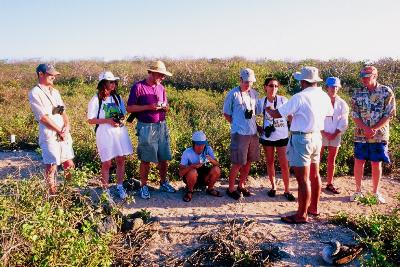 At
each visitors' site a discreetly marked trail provides excellent
views of wildlife, vegetation and landscape of the island.
Most of the trails are less than a mile long but can be difficult
underfoot, leading over rough lava or uneven boulders. There
are also one or two longer hikes in the highlands. At
each visitors' site a discreetly marked trail provides excellent
views of wildlife, vegetation and landscape of the island.
Most of the trails are less than a mile long but can be difficult
underfoot, leading over rough lava or uneven boulders. There
are also one or two longer hikes in the highlands.
The different sites are varied in their scenery
and vegetation but some animals are common at nearly all of
them. These include Galápagos sea lions, marine iguanas, lava
lizards and a variety of coastal birds.
In addition to the visitors' sites on land,
the Galápagos offer excellent scuba diving, though these aren't
recommended for beginners. However, many snorkeling spots
offer anyone the chance to see the colorful underwater life
of the Galápagos Islands.
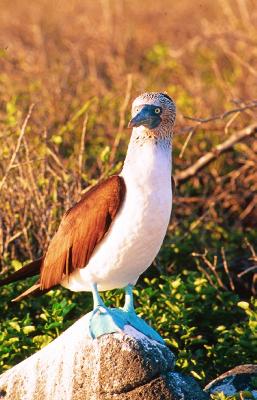 Almost
without exception, visitors are extremely impressed with what
they see and do on the Galápagos Islands. "The trip of a lifetime,"
they say, "Like nowhere else on earth" or "Paradise on this
planet." The only negative things you'll hear anyone say will
be about increasing threats to the environment and wildlife,
and fears that the fragile ecosystem will be further damaged. Almost
without exception, visitors are extremely impressed with what
they see and do on the Galápagos Islands. "The trip of a lifetime,"
they say, "Like nowhere else on earth" or "Paradise on this
planet." The only negative things you'll hear anyone say will
be about increasing threats to the environment and wildlife,
and fears that the fragile ecosystem will be further damaged.
PRACTICAL INFORMATION
The park entrance fee is currently US$100 per passenger,
payable in cash at the airport. Children under 12 and students
under 26 (with a valid student card) pay half price. Credit
cards and travelers' checks are not accepted.
95% of this fee is retained by the Galápagos:
40% goes to the park (more than in mainland parks), 40% to
local authorities, and the rest to other local organizations.
The sun on the equator is extremely fierce,
so lather yourself in high-factor suncream, wear a sun hat
and sunglasses, and snorkel wearing an old T-shirt or long-sleeved
shirt.
Although mosquitoes aren't generally a problem,
if the wind drops on some islands they can appear in force.
Carry repellent and sting relief cream with you in your day
bag.
It's unlikely to rain during your visit, but
pack a lightweight waterproof jacket just in case. Don't forget
to bring your passport.
Useful and informative websites for the
islands include:
The
International Galápagos Tour Operators' Association
The
Charles Darwin Foundation
The
Galápagos Coalition (of scientists, lawyers and biologists)
The author and guide Michael
Jackson
Terraquest
 An excellent travel, boat information and
last-minute-deals site: An excellent travel, boat information and
last-minute-deals site:
www.guide2galapagos.com
For Scuba Diving contact:
Galápagos Sub-Aqua
Scuba Iguana
Suggested Books:
Historical: Johanna Angermeyer's My Father's Island
(1989), Margaret Wittmer's Floreana, or John Treherne's
The Galápagos Affair (1983).
There are several editions in print of Darwin's The Voyage
of the Beagle which include the captivating chapters on
the islands.
For more on Darwin and evolutionary theories, both Alan Moorehead's
Darwin and The Beagle (1969) and Jonathan Weiner's
Pulitzer Prize-winning The Beak of the Finch (1994)
are excellent.
General: Michael D'Orso's Plundering Paradise (2004) is excellent; John Hickman's The Enchanted Islands; The
Galápagos Discovered (1985).
Natural History: Michael Jackson's Galápagos.
The best birding guide is A Field Guide to the Birds of
the Galápagos (1992) by Michael Harris.
The South
American Explorers in Quito sells a useful and up-to-date
information pack to the islands. There's also very helpful
advice on their Bulletin Board here.
And here are more photos,
since you can never get enough of the Galápagos...
|